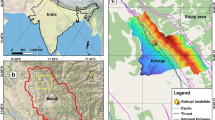Abstract
In the present paper, the results are explained for an experimental and numerical study on scouring phenomenon around a rectangular, impermeable and non-submerged bridge abutment cross section with perpendicular attitude to the flow axes. In this study, SSIIM 2.0 is used to simulate the scouring problem at the abutment. SSIIM 2.0 is a three-dimensional computational fluid dynamics program that uses a finite volume method to discretize the equations. According to the results, the k–ε turbulence model with some RNG extensions is the best model for predicting turbulence around the rectangular abutment. In addition, different grids are compared in the simulations and the best grid is selected based on the accuracy of numerical results and the computation times. Finally, the findings are explained, and the bed changes and local scour profiles resulting from the numerical simulation are compared with the available experimental results. It is concluded from the achieved results that SSIIM 2.0 numerical modeling is capable of simulating scouring around a rectangular abutment.






Similar content being viewed by others
References
Shirhole A, Holt R (1991) Planning for a comprehensive bridge safety program. Transp Res Rec 1290:39–50
Kattell J, Eriksson M (1998) Bridge scour evaluation: screening, analysis, and countermeasures. F.S. United States Department of Agriculture, Washington
Lagasse PF (1997) Instrumentation for measuring scour at bridge piers and abutments. American Association of State Highway Transportation Officials National Research Council. Transportation Research Board National Cooperative Highway Research Program, National Academy Press, Washington D.C.
Melville BW, Coleman SE (2000) Bridge scour. Water Resources Publication, Highland
Karami H et al (2012) Verification of numerical study of scour around spur dikes using experimental data. Water Environ J 28:1–11
Dargahi B (1990) Controlling mechanism of local scouring. J Hydraul Eng 116(10):1197–1214
Chiew Y-M (1992) Scour protection at bridge piers. J Hydraul Eng 118(9):1260–1269
Dey S, Barbhuiya AK (2005) Time variation of scour at abutments. J Hydraul Eng 131(1):11–23
Kayaturk S, Kokpinar M, Gogus M (2004) Effect of collar on temporal development of scour around bridge abutments. In: 2nd international conference on scour and erosion, IAHR, Singapore
Kumar V, Raju KGR, Vittal N (1999) Reduction of local scour around bridge piers using slots and collars. J Hydraul Eng 125(12):1302–1305
Li H-MT, Kuhnle R, Barkdoll B-MT (2005) Countermeasures against scour at abutments. Lab Publ 49:150
Mashair M, Zarrati A Rezayi A (2004) Time development of scouring around a bridge pier protected by collar. In: 2nd international conference on scour and erosion, ICSE-2, Singapore
Melville BW, Dongol D (1992) Bridge pier scour with debris accumulation. J Hydraul Eng 118(9):1306–1310
Molinas A, Kheireldin K, Wu B (1998) Shear stress around vertical wall abutments. J Hydraul Eng 124(8):822–830
Akib S, Jahangirzadeh A, Basser H (2014) Local scour around complex pier groups and combined piles at semi-integral bridge. J Hydrol Hydromech 62(2):108–116
Akib S et al (2011) Influence of flow shallowness on scour depth at semi-integral bridge piers. Adv Mater Res 243:4478–4481
Basser H et al (2014) Adaptive neuro-fuzzy selection of the optimal parameters of protective spur dike. Nat Hazards 73:1–12
Jahangirzadeh A et al (2014) Experimental and numerical investigation of the effect of different shapes of collars on the reduction of scour around a single bridge pier. PLoS One 9(6):e98592
Jahangirzadeh A et al (2014) A cooperative expert based support vector regression (Co-ESVR) system to determine collar dimensions around bridge pier. Neurocomputing 140:172–184
Khosronejad A, Kang S, Sotiropoulos F (2012) Experimental and computational investigation of local scour around bridge piers. Adv Water Resour 37:73–85
Karami H et al (2012) Verification of numerical study of scour around spur dikes using experimental data. Water Environ J 28:124–134
Akib S, Mohammadhassani M, Jahangirzadeh A (2014) Application of ANFIS and LR in prediction of scour depth in bridges. Comput Fluids 91:77–86
EL-Ghorab EA (2013) Reduction of scour around bridge piers using a modified method for vortex reduction. Alexandria Engineering Journal 52(3):467–478
Kang S, Khosronejad A, Sotiropoulos F (2012) Numerical simulation of turbulent flow and sediment transport processes in arbitrarily complex waterways. In: Environmental fluid mechanics, memorial volume in honour of Prof. Gerhard H. Jirka, CRC Press, Boca Raton, pp 123–151
Khosronejad A et al (2013) Computational and experimental investigation of scour past laboratory models of stream restoration rock structures. Adv Water Resour 54:191–207
Paik J, Escauriaza C, Sotiropoulos F (2010) Coherent structure dynamics in turbulent flows past in-stream structures: some insights gained via numerical simulation. J Hydraul Eng 136(12):981–993
Khosronejad A et al (2011) Curvilinear immersed boundary method for simulating coupled flow and bed morphodynamic interactions due to sediment transport phenomena. Adv Water Resour 34(7):829–843
Olsen NRB (2006) A three-dimensional numerical model for simulation of sediment movements in water intakes with multiblock option. User’s manual
Van Rijn LC (1987) Mathematical modelling of morphological processes in the case of suspended sediment transport. Waterloopkundig Laboratorium, Delft
Wu W, Rodi W, Wenka T (2000) 3D numerical modeling of flow and sediment transport in open channels. J Hydraul Eng 126(1):4–15
Khosronejad A et al (2007) 3D numerical modeling of flow and sediment transport in laboratory channel bends. J Hydraul Eng 133(10):1123–1134
Acknowledgments
The financial support of the high impact research grant from University of Malaya (UM.C/625/1/HIR/61, account number: H-16001-00-D000061) is gratefully acknowledged. The authors would also like to thank Amirkabir University of Technology for facilitating of the experiments.
Author information
Authors and Affiliations
Corresponding authors
Rights and permissions
About this article
Cite this article
Basser, H., Cheraghi, R., Karami, H. et al. Modeling sediment transport around a rectangular bridge abutment. Environ Fluid Mech 15, 1105–1114 (2015). https://doi.org/10.1007/s10652-015-9398-z
Received:
Accepted:
Published:
Issue Date:
DOI: https://doi.org/10.1007/s10652-015-9398-z




